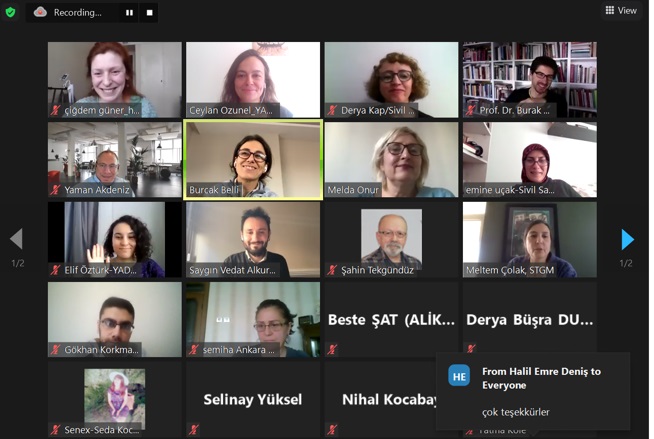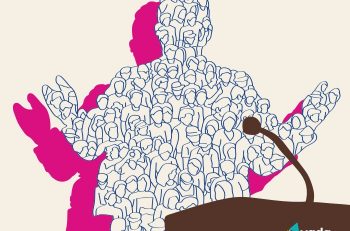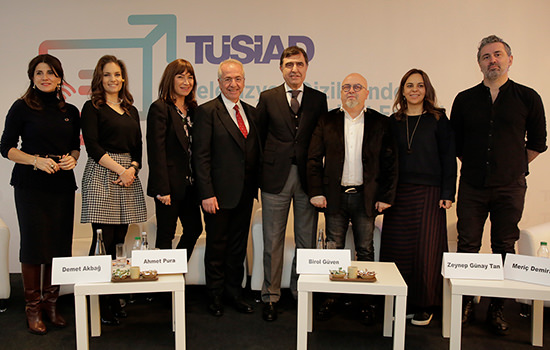Representation of NGOs in national media: “Invisible or Decorative Subject”

The representation of NGOs in the national media prepared by The YADA Foundation: Media Analysis report emphasizes that although the visibility of non-governmental organizations during the pandemic has increased slightly, the state of 'decorative' participation in the national media continues.
The YADA Foundation announced the results of its research with a panel entitled “Civil Society and the media: Intersecting, Shrinking Areas” with the participation of representatives of the civil society and the media. In addition to the research results, the panel discussed the reasons for the ineffectiveness in the civil society and the media which are two important institutions of democratization.
Ceylan Özünel from YADA (Life Foundation) Foundation, who received the first mention at the opening of the panel, noted that in a media analysis called “representation of the NGOs in the national media”, they aim to reveal what barriers affect civil society’s presence in the national media.
Representation of the NGOs in the National Media: Saygın Vedat Alkurt from Adhoc Research, who conducted Media Analysis Research with Prof. Dr. Burak Özçetin, shared the goal, method and quantitative findings of the study they conducted with the data they obtained from traditional media. Alkurt stated that how visible the NGOs operating in Turkey are in the national media; how the general view of civil society news is; which event and type of news stand out in terms of visibility; which non-governmental organization can take place in the national media more than its field of activity and non-governmental topography classification, and that the contents are made to determine the tones of NGOs and society.
Projection of Civil Society in the National Media
Alkurt, clarifying the research method, data collection and coding, explained that according to the research carried out between 1 July 2019 and 1 July 2020, 2358 out of 42,597 raw content obtained by searching all data on the media representation of NGOs reflected in the national media with the keywords “association”, “foundation”, “cooperative”, identified as out-of-context and the remaining 40,239 news was described as news related to civil society and formed the basis of the research. From the 40,239 data in question, a simple random selection was made, 2274 news was selected as a sample, and then the content was categorized by coding according to 46 different variables.
In addition to preliminary findings on the reflection of civil society in the national media, Alkurt said that, a total of 14 in-depth interviews with experts from the civil society (5), media representatives (4), private sector (2) and the academy (3) were evaluated to understand the reasons behind the non-appearance of NGOs in the media. In addition to these negotiations, about 110 NGO representatives conducted interviews and made a dialogue mapping, Alkurt said that this map will also be published soon.
Civil Society as a “Decorative Subject” or Unequivocally “Invisible” Actor in the Media
Highlights from the findings of the NGO representation survey in the national media are:
- “New” is the most used keyword in the NGO related news on the national media between 2019-2020. The word “new normal”, “new Turkey”, “new system” and “new virus” in the news has become a prominent concept for the civil society news on the axis of both the economic crisis and the transition to the new government system.
- Between 2019-2020, the representation of the civil society on the national media remained at a low level. There was a 9% drop from the previous survey in 2018-2029. In 2019-2020, the main topics covered by the study were pandemic and economic problems, while issues such as human rights were left behind. Although civil society activities in the conditions of the epidemic allowed an increase in news, the decrease in the rate of news publication was noted as remarkable data.
- In the 12 months between 2019-2020, the proportion of the civil society news among all the news was 8.2%. In all news the average number of daily news in which “foundations, associations or cooperatives” were discussed, was 110 and 3357 news on a monthly basis.
- Civil society was positioned as a decorative subject and secondary actor rather than a subject on its own in the majority of these 8.2% news, which is determined as civil society news in the national media. Only the name of the NGOs was included in the news, while their activities or statements were not included. In only 1 out of every 3 NGO content reports, NGOs became the main subject of the news.
- The category in which NGO news is most included is the “news” category of the newspapers. The national media “invisibility” of NGOs is further enhanced in columnists and in interviews where they can express themselves directly. According to the civil topography classification, political-axis NGOs are the most columnist-producing NGOs with 27%.
- As a result of the pandemic, the visibility of NGOs that make up professional organizations has increased (46%), while NGOs that conduct advocacy activities have decreased. Again, the opinion of experts was more included in the news, while those who advocate in areas such as the environment and human rights were less involved.
- In 2019-2020, the sensational approach favoured by the media to make the news read has also been repeated by the civil society. Most of the news has content that will create negative thoughts about both the NGO that is the subject of the news and the civil society in general. In the formation of this negative approach in the news, both the way the media reported and the way their NGOs defended had an effect. The news painted a picture of revelation and pessimism. The news in question, which had a negative approach, directly targeted and criminalized the civilian movements.
- Media outlets with different world views and political positions featured incriminating content that directly targeted civilian movements. Here, too, projections of polarization were seen.
- Another finding that attracted attention in the civil society news in the national media was the increased use of data in NGO news. Proportionally increased data usage compared to the previous two years (2017-2018) functioned as a support for the news that highlighted the negative. Data sharing was often done, especially in the context of the pandemic and the economy in 2020.
- The distance between civil society and the public has continued as in the previous two years. The public opinion was often not included in the news content in question. The proportion of the NGO news that included the views of public managers was only 13%. The news of the NGOs, which fall into the category of citizen associations, was among the news with the highest proportion of public opinion with 28%. The Visits to fellow countrymen associations and statements constituted a large part of these news.
- The ratio of public addressing/calling on the news involving civil society was quite low in total. In all civil society News, the proportion of publicly called news was 4%, but there was a significant increase in certain categories. The NGOs operating in the field of human rights were the highest proportion of calling public institutions, about 29%.
- The call made by the civil society to decision makers at a low level also applied to the society: the rate of calls made to the public remained at 3%. The consumers were the most called-upon segment of the society. Despite the pandemic, there were not many calls in the media that were reflected on the society by NGOs.
- Again, another important finding of the study was the low rate of joint participation of NGOs in the national media. In NGO news, the rate of being referred to by another NGO remained quite weak at 7%. Therefore, 93% of NGO News did not have another NGO name. About 7% of the NGOs appeared together, while NGOs were portrayed not through oppositions, but through coexistence.
“Civil Society in the Grasp of Invisibility”
Prof. Dr. Burak Özçetin who shared the qualitative explained how important for a civil society to be visible in the media through the findings of his interview with 14 people within the scope of the research.
Explaining that the visibility of NGOs in the media is critical both in terms of increasing the impact power of NGOs and ensuring their financial sustainability, Özçetin shared the following points that the experts referred in common;
- It is important that civil society is visible in the media; because the visibility is vital to achieving the objectives of the relevant NGO.
- There is a strong opinion that NGOs do not get enough coverage in the media and they are not visible enough.
- The experts believe that Turkish civil society does not care about communication with society, does not aim to develop expertise on this issue and does not devote resources to it.
Özçetin listed the problem areas in front of the media being able to find media coverage from NGOs with the determinations of the experts he interviewed as follows;
- For a report to be valued by the media, it must be urgent, magnitude, proximity, and often negative.
- Because news about NGOs is often stuck in one of these filters, the NGOs need remarkable content to be among these priorities.
- The NGOs need to use the language of the media to find a place in the media.
The experts who are referred to their opinion within the framework of opinions that define the axis of polarization in Turkey on the media, where news that civil society does not have a place in the national media, often use the depiction of “monoblocmedia”, while highlighting concerns about state control and the nature of the media. As for public control, two main arguments seem to prevail: The direct political interventions of the state and the relationship of capital driving the mainstream media with the politics.
Another point that experts in the study pointed out is the way of media positioning NGOs in a problematic way. Accordingly, the national media positions NGOs in 5 different ways in the news:
1-NGOs as figurative actor: decorative positioning, participation as a secondary or figurative actor aiming to increase the legitimacy of an idea or approach.
2-NGOs as an element of incapacity: presenting NGOs and NGO beneficiaries as incapable actors in the media and dominating a language that looks from the hill.
3-NGOs as a criminal element: NGOs are usually involved in the media by being criminalized or associated with a crime.
4-NGOs as players of the opposite team: Language established through the relationship of Opposition, always negative coverage of “independent” NGOs in the pro-government media, the language of the opposite neighborhood.
5-NGOs as reactive actors: NGOs are mostly involved in the media based on problems and reactions, the microphone is extended when there is a crisis.
According to Özçetin, the most basic finding reached in the research is the confirmation that the visibility issue is bilateral. On the one hand, the media do not see the NGOs for various reasons, on the other hand, the NGOs do not attach enough importance to the communication with the media in general. Beyond the polarization discussions, Özçetin evaluated the findings in terms of media and capital relations and underlined that unlike other periods, Turkey is going through a “very interesting” period.
“Has good journalism turned into civil society activity?”
The second part of the panel, entitled “Civil Society and Media in the Grip of Polarization”, was moderated by Emine Uçak from Sivil Sayfalar Melda Onur, Burçak Onur Belli and Prof. Dr. Yaman Akdeniz participated.
Emine Uçak said in his speech that the civil society and the media have become partners in exploring and making visible problems, noting that both actors should be in a structure that can perform this function but at the moment, an alternative media is mentioned because the media cannot perform its function. Saying that civil society is also an actor who has become ineffective as a result of its polarization and closure to its own subject, Uçak said that “good journalism itself has become civil society” expressed by Ali Duran Topuz at a meeting. He expressed that he found it more appropriate to be evaluated within the axis of “field and new media” discussions.
“Each Actor Created His Own Media”
Melda Onur from the Social Rights Association, who received the first mention in this section, noted that there is no mainstream media in Turkey, noting that the pressure of power on the media is decisive in the emergence of many independent media outlets after the trip process. Onur said that the influence of civil society on the politics within the framework of his political experience is excessive, contrary to what is believed, and stressed that despite the rules that allowed the civil sphere to expand in the early periods of the ruling party. Over the time it has created a parallel media and NGO and the process continues in this way. Onur stated that it is not necessary to despair with the findings of the research, and stressed that each NGO or even each actor can create their own media and therefore their own sphere of influence using digital opportunities.
“There is a loss of skill and novelisation in the media”
After Onur, the journalist Burçak Onur Belli shared her observations and experiences about her periods working for Turkish and foreign press together with Press in Arrest. I think journalism should remain as journalism,” said Belli, and shared her opinion that journalism, which has passed the editorial control system and done properly, should remain as the most influential source of the news. According to Belli who stressed that she does not find it right to use concepts such as ”alternative media“ and that all media channels must adhere to the same principles, all media ”have a loss of skill and muscle” in general.
“The Visibility Remains Second To Other Problems”
The last speaker of the panel was Prof. Dr. Yaman Akdeniz from Bilgi University, interpreted the findings of the study through the Freedom of Expression Association and the Disabled Web experience and touched on many problems of the civil society. In his speech, Akdeniz noted that the current legal ground and the contraction in the civil field in Turkey, the height of the number of blocked contents that they place on the disabled website, and their sites are also blocked, noting that I was initially a choice not to be visible from the point of view of their associations. Akdeniz, 2 years ago, despite the establishment of the Freedom of Expression Association’s website recently opened, rights violations on their websites when they put the disabled website 2 times blocked, the process moved to the Constitutional Court and continued their legal struggle, he said.
Drawing attention to the issue of resource and project management, which is one of the vital problems of civil society, Akdeniz emphasized the need for funds that NGOs can get support quickly and use flexibly in a way that they can continue their main activity areas. Another determination of the Akdeniz was that both civil society and the media were forced to choose not to publish or make some content visible, operating the mechanism of self-censorship due to political pressure and sanctions. Akdeniz, who argued that media visibility remained secondary to other problems of the civil society, emphasized that supervisory pressure on civil society, regulations that envisage serious sanctions, and other bureaucratic obstacles, including the law on preventing the financing of the proliferation of weapons of mass destruction.





Bizi Takip Edin